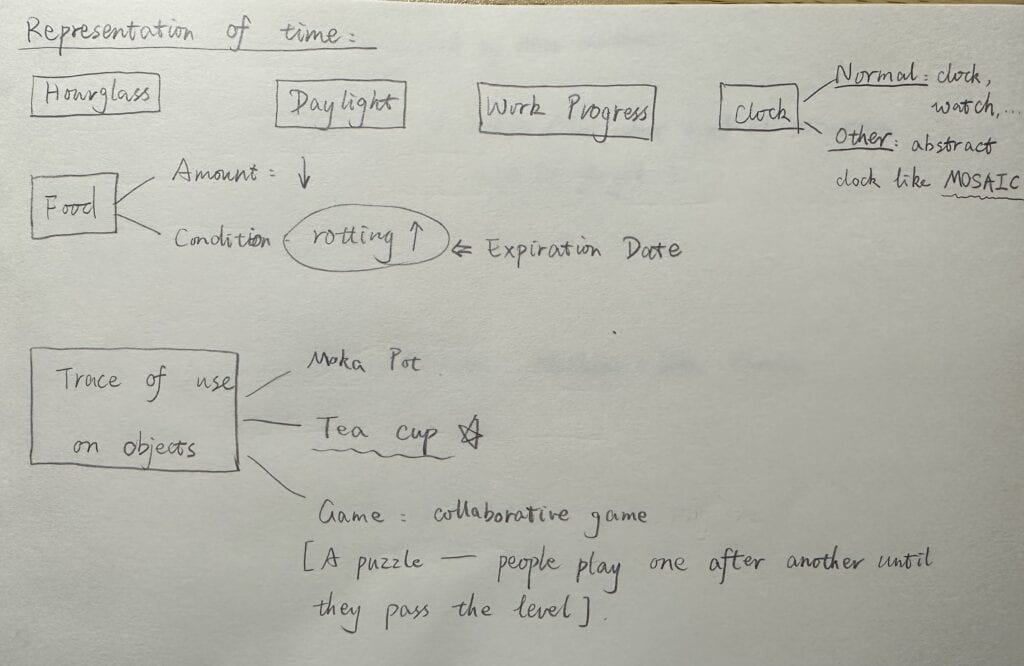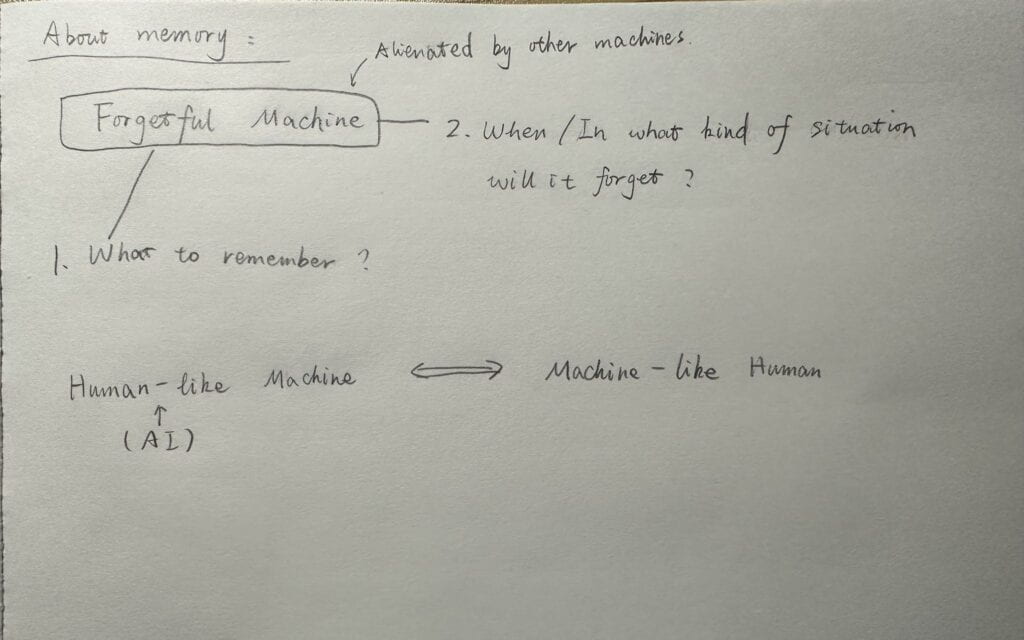Yesterday, I read 4 short readings: ‘Past Future/Split Attention‘, ‘Crystals‘, ‘Analogue, Chance, and Memory’, and ‘The Sadness of the Machine’. They focus on different topics, but I think they talk about one thing in common: memory. Below are my thoughts after reading these materials.
Past Future/Split Attention by Dan Graham
This reading material is short but took me quite some time to follow. It depicts a scenario where two people act based on the following rules: “While one person predicts continuously the other person’s future behaviour, the other person recounts (by memory) the other’s past behaviour. “
This scenario forms a feedback/feed-ahead loop with only two people. I labeled them A and B, their actions a and b, and B‘s verbal description c. Below is my understanding of the sequence of actions in this performance:
- Let B perform action b first.
- When A sees b, A predicts B‘s behavior and perform the predicted action (a).
- Then, a as a prediction/feed-ahead information is seen by B.
- B makes its next move b’. Simultaneously, B verbally describes his/her previous movement (c).
In this way, past (c), present (b), and future (a) come together and affect each other. This changes the normal understanding of cause and effect because our envisioned future can change our actions at present.
This article makes me think further about feed-forward. It is easy to understand feedback: some examples are people learning from their previous mistakes, and are affected by their past experiences. But what are some examples of feed-forward? Where does the feed-forward information come from?
Before the invention of the time machine, the only way to get feed-forward is by prediction, as what performer A does in the article. There are many ways to make predictions. In human history, people predicted future events either based on their past experiences or by divination. Now with more advanced technology like mathematical modeling and machine learning, we can predict the future more accurately. Some predictions affect our actions now: for example, forecasts on the stock market influence investors’ decisions.
Crystals by Daniel Birnbaum
This article writes about the potential of multi-screen installation in terms of temporal possibilities. It mainly introduced the work of Eija-Liisa Ahtila’s artworks, which are formed by multiple screens, some even with multiple soundtracks playing simultaneously. This form allows the artist to utilize the human mind. As written in the article, “The mind is a multi-channel apparatus, and several programmes are active and viewed at the same time”.
This work makes me think about what I can do with multiple screens. Maybe it is an ideal way to tell a story using the Rashomon effect, in which the truth is vague but the interpretations are multiple and conflicting.
Analogue, Chance, and Memory by Michael Newman
This article is about the analogue medium. Analogue records have a direct connection to the objects being recorded, but they are subject to change, decay, or wear out. On the other hand, digital records lose information from the day they are produced due to their sampling mechanisms but are much less affected by the passing of time. In short, the analogue medium is closer to the exact and perfect, while the digital medium is not perfect but more durable.
This article makes me think of the representation of time. Below are records of my ideas.

My favorite idea around time representation is the teacup. I have been interested in a kind of Chinese teaware named “Ru Kiln porcelain”. Ru kiln porcelain tea cups will produce new crack textures every time you make tea with them. I think this is a very interesting interaction between the teacup and the tea maker, although it involves no digital technology. However, it is possible to transfer this experience into a digital one.
The Sadness of the Machine by Ollivier Dyens
This article discusses the phenomenon of memories moving from human brains to machine memory. With the popularization of digital devices with memory, people’s intimate memories become public, and one’s past, though won’t completely disappear from history (as discussed in the previous 3 articles), will also never fade once gets written into computer memory.
It has both good side and bad side. Privacy is at stake, while narratives obtain more possibilities. Before, the crystallized moments were limited and relied on human memories (retention, as Husserl calls it). With machines, more and more human memories are documented in machine memory, and it is easier than at any time in history to recollect them.
In this article, the author suggests that humanity is flowing from humans to machines. This makes me think of Artificial Intelligence (AI), which I have been particularly interested in since last year. People used to think that creativity was one of the key attributes to distinguish humans from machines/programs. But looking at AI art now, people become confused, rethinking the definition of creativity. Earlier this year, I learned from another article that the current “humanity” in our understanding has remained unchanged since The Renaissance. However, as machines become more and more like humans, the definition of human is likely and urgently facing a new round of evolution.
Then I thought further: As machines become more like humans, what if they also learn our flaws? For example, how will a machine function if it is forgetful just like us and other analog media?

Conclusion
The four readings discussed above are inspiring to me because I got to know many new concepts and methods.
Below are some concepts that I want to explore further and integrate into my work if possible:
- Feed-forward
- Time crystallization
- Temporal polyphony (multiple tracks of awareness)
- perceptual presence: impression + retention + protention (expectation)
- recollected past
- empathy
- imagination
- …
Below are some ideas/themes that I want to develop further (but I will eventually select only one of them):
- Ru Kiln porcelain
- Forgetful Machine